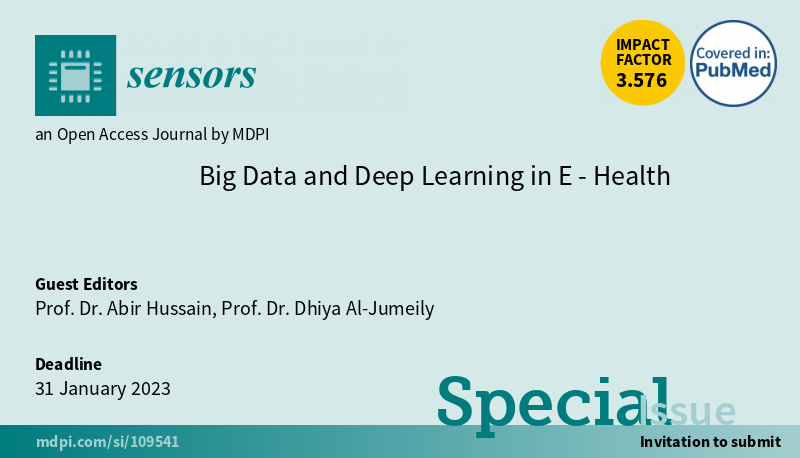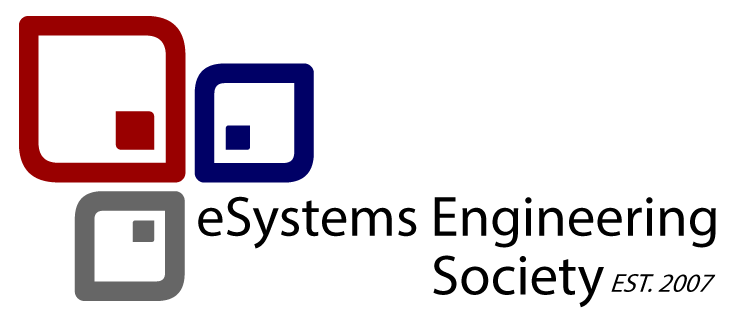Selected papers will be invited to submit to sensors:
Editor-in-Chief: Prof. Dr. Vittorio M.N. Passaro Dipartimento di Ingegneria Elettrica e dell’Informazione (Department of Electrical and Information Engineering), Politecnico di Bari, Via Edoardo Orabona n. 4, 70125 Bari, Italy
Editor-in-Chief: Prof. Abir Hussain, UK and Prof Dhiya Al-Jumeily OBE, UK.
Sensors is the leading international, peer-reviewed, open access journal on the science and technology of sensors and biosensors. Sensors is published monthly online by MDPI. Sensors special issue journal is indexed by the Science Citation Index Expanded (Web of Science), MEDLINE (PubMed), Ei Compendex, Inspec (IET) and other databases. Manuscripts are peer-reviewed and a first decision provided to authors approximately 24 days after submission; acceptance to publication is undertaken in 5.6 days.
Authors of the selected papers from the conference are invited to submit the extended versions of their original papers and contributions regarding the following topics that related to the application in sensors:
- Sensors, sensors applications, and sensors platforms;
- AI and its applications;
- Biomedical intelligence;
- Bio-informatics, health informatics, and biocomputing;
- Computational intelligence;
- Novel data processing and analytics, tools, and systems;
- Big Data systems;
- Deep learning methods and techniques;
- General session: eSystems engineering.

Special Issue No. 3
Special Issue on “Artificial Intelligence in Energy Grids: Challenges and Opportunities”
Selected papers also will be invited to submit to energies:
Editor-in-Chief: Prof. Dr. Vittorio M.N. Passaro Dipartimento di Ingegneria Elettrica e dell’Informazione (Department of Electrical and Information Engineering), Politecnico di Bari, Via Edoardo Orabona n. 4, 70125 Bari, Italy
Editor-in-Chief: Dr. Thar Baker, UAE and Prof Dhiya Al-Jumeily OBE, UK.
energies is a peer-reviewed, open access journal of related scientific research, technology development, engineering, and the studies in policy and management and is published semimonthly online by MDPI. The European Biomass Industry Association (EUBIA), Association of European Renewable Energy Research Centres (EUREC), Institute for Chemical Processing of Coal (IChPW), International Society for Porous Media (InterPore), CYTED and others are affiliated with Energies and their members receive a discount on the article processing charges.
While smart grids are becoming more prevalent, especially with the integration of the capabilities of artificial intelligence (AI) and the Internet of Things (IoT), the “consumer-to-producer” relationship and its operations are yet to be fully clear and optimised; in other words, a smart grid promotes the two-direction flow of energy and information (i.e., grid–consumer–grid), implying that smart grids have specific obligations towards their consumers. In the same vein, consumers should have their own responsibilities to the smart grid. Currently, from the smart-grid side, it continues monitoring the power plants and responds to consumer preferences and their individual appliances, signifying the role of smart grids; on the other hand, from the consumer side, it is still not crystal clear what their contributions to the smart grid cycle are, since, up to now, as the term indicates, consumers consume energy and have no other tangible and practical role to play.
“Consumers’ waste”-to-energy production is a field demonstrating the potential participation of consumers in the above smart grid cycle. As per the Waste Management World (https://waste-management-world.com/), 12% of approximately 300 million tons of waste produced by Americans has now been converted into energy by specialized waste-to-energy plants. However, this process is deemed expensive and unattractive to consumers.
The aim of this Special Issue is to assemble researchers from academia, the industry and individuals working on relevant research areas to share their latest accomplishments and research findings within the research community, focussing on the utilisation of AI, IoT, machine learning, energy cloud and federated learning to encourage and incentivise the role of consumers towards smart grids, such that their participation becomes more attractive and inexpensive.
The Special Issue aims to cover topics that include, but are not limited to, the below topics:
- Optimization of energy grid;
- Applied machine learning for energy grids;
- Artificial intelligence for network-of-networks;
- Cyber-physical system of energy cloud;
- Two-way energy sharing;
- Demand-side management;
- Enabling technologies (e.g., social media) impact on energy cloud;
- IoT for off-grid smart homes and smart cities;
- Applications of energy cloud (network-of-networks);
- Critical infrastructure protection;
- Sensor analytics in energy grids.
===========================
Special Issue No. 4
Special Issue in the Journal of Computational and Mathematical Methods in Medicine“,
Evolving Artificial Intelligence in Analysis of Cardiovascular Disease
Selected papers also will be invited to submit to this special issue
“Evolving Artificial Intelligence in Analysis of Cardiovascular Disease”
Description
Artificial intelligence (AI) and machine learning (ML) based applications have been found useful in many fields of medicine. The use of the enhanced computing power of machines in clinical medicine and diagnostics has been explored in cardiovascular disease treatment. In cardiovascular medicine, AI-based systems have found new applications in cardiovascular imaging, cardiovascular risk prediction, and newer drug targets. AI-based applications have enhanced our understanding of different phenotypes of heart failure and congenital heart disease. These applications have led to newer treatment strategies for different types of cardiovascular diseases, a newer approach to cardiovascular drug therapy and post-marketing surveys of prescription drugs. In cardiovascular medicine today, ML/AI has found a wide range of applications in cardiovascular drug therapy, pharmacogenomics, heart failure management, cardiovascular imaging, and diagnostics. AI can provide tools to apply precision medicine and big data in cardiovascular medicine, therefore augmenting the effectiveness of the cardiologist’s work. AI/ML algorithms can analyse vastly heterogeneous clinical data without any assumptions, for accurate prediction and classification.
Cardiovascular medicine can therefore benefit from the incorporation of AI. Here we have described the impact of AI in various fields of cardiovascular medicine. AI and machine learning have the potential to revolutionize the field of cardiovascular medicine. AI has found applications in the diagnosis of obstructive coronary artery disease, determination of left ventricular ejection fraction, prediction of abnormal fractional flow reserve in patients undergoing coronary computed tomography angiogram (CCTA), and readmission rates in heart failure patients.
The aim of this Special Issue is to focus on recent developments of artificial intelligence/machine learning in cardiovascular disease. Original research and review articles are welcomed.
Potential topics include but are not limited to the following:
- AI/ML in cardiovascular imaging for analysis of coronary artery disease
- AI/ML algorithm for predicting of patients with acute heart failure
- AI/ML in arrhythmias and cardiac electrophysiology
- AI/ML in mobile system for cardiovascular health management
- AI/ML exploration of molecular data in the risk prediction of cardiovascular diseases
- AI/ML in personalized cardiovascular medicine and cardiovascular imaging
- AI/ML in predict of cardiovascular complications in chronic kidney disease patients
- AI/ML in arrhythmias and cardiac electrophysiology
- AI/ML in integrating blockchain technology for cardiovascular medicine
Special Issue No. 5
Special Issue on “Optoelectronic Detection Technology and Artificial Intelligence for Industrial Application”
Selected papers will be invited to submit to sensors:
Editor-in-Chief: Prof. Dr. Vittorio M.N. Passaro Dipartimento di Ingegneria Elettrica e dell’Informazione (Department of Electrical and Information Engineering), Politecnico di Bari, Via Edoardo Orabona n. 4, 70125 Bari, Italy
Guest Editors: Prof. Dr. Ahmed N. Abdalla, Prof. Dr. Jasni Mohamad Zain, Dr. Hai Tao, Dr. Karrer M. Alghazali, Prof. Dr. Dhiya Al-Jumeily OBE
Sensors is the leading international, peer-reviewed, open access journal on the science and technology of sensors and biosensors. Sensors is published monthly online by MDPI. Sensors special issue journal is indexed by the Science Citation Index Expanded (Web of Science), MEDLINE (PubMed), Ei Compendex, Inspec (IET) and other databases. Manuscripts are peer-reviewed and a first decision provided to authors approximately 24 days after submission; acceptance to publication is undertaken in 5.6 days.
Authors of the selected papers from the conference are invited to submit the extended versions of their original papers and contributions regarding the following topics that related to the application in sensors.
This Special Issue, entitled “Optoelectronic Detection Technology and Artificial Intelligence for Industrial Application”, will provide insights into current trending topics in optoelectronic sensors, intelligent detection, and data mining, among others. Moreover, this Special Issue welcomes newly developed methods and ideas combining data obtained from various sensors in, but not limited to, the following fields:
-
-
Optoelectronic sensors
-
Smart optoelectronics;
-
Optoelectronic data mining
-
Optoelectronic diagnostics
-
Industrial applications based on optoelectronic sensors;
-
Optoelectronic detection technology.
-







